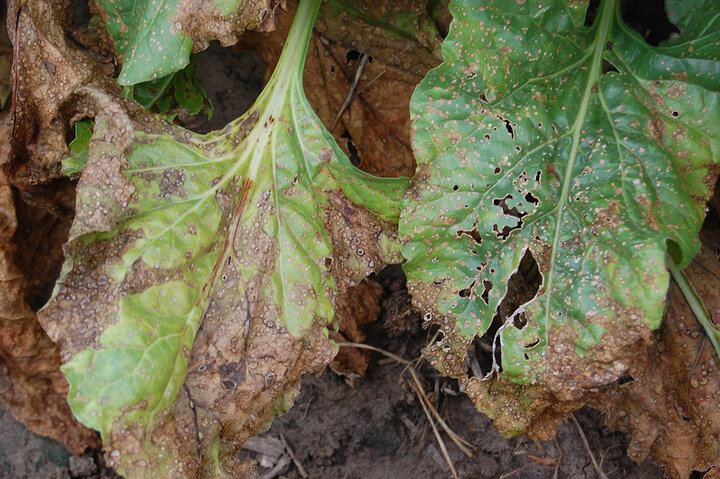Introduction
Cercospora leaf spot (CLS) has long been problematic to sugarbeet production throughout the eastern and Great Lakes production areas of the United States and is considered to be the most important and destructive foliar disease for this crop. Its presence has additionally played a critical role in Nebraska’s agricultural history, particularly influencing the locations of cultivation and processing of sugarbeets within the state. The story of this disease and its impact on sugarbeet production in Nebraska is the rest of the story.
Cercospora Leaf Spot
CLS is caused by the airborne, foliar fungal pathogen, Cercospora beticola, and disease development is strongly dependent upon several very specific environmental conditions. These include periods of high humidity or extended leaf wetness for more than 11 hours and warm temperatures (higher than 60°F at night and 80-90°F during the day). Without all of these conditions working simultaneously, infection, disease spread and damage to beet crops are greatly reduced.


Sugarbeet Production Begins
Sugar production in Nebraska began in 1890 after the first processing factory was established in Grand Island by the Oxnard Beet Sugar Company. Other factories in Nebraska were started further east in Norfolk (1891) and Ames (1899), but sugarbeet acreage began to drop when growers in eastern Nebraska discovered it was more profitable to raise corn and livestock.
Interest in sugarbeet production began to shift westward at the turn of the 20th century. This was due partially to the development of irrigation and the expansion of railroads westward through Nebraska. Although much of the production moved to the far western side of the state (Panhandle) after 1910 with the construction of the factory in Scottsbluff, sugarbeet production and processing was still focused in central Nebraska near the already well-established Grand Island factory.
Another emerging factor encouraging westward migration of sugarbeet production was the increasingly severe problems with Cercospora leaf spot in the more humid areas of eastern Nebraska. Humidity and annual precipitation decrease gradually from east to west across Nebraska, averaging 32-35 inches in the east to less than 15 inches in the west.
Production Moves West
Although the disease was well known and commonly found in central Nebraska, it was of minor importance until the late 1950s and early 1960s. The 1950s were characterized by a series of dry years. These conditions forced farmers to dig thousands of new irrigation wells. This resulted in large increases of new center pivot irrigation systems throughout central Nebraska in an effort to improve yields and attain profitability more consistently with controlled irrigation.
Furthermore, the usage of fungicides became routine in an effort to reduce disease losses, but this system became unsustainable. Sugarbeet production ceased in central Nebraska after the factory in Grand Island closed in 1964 and completely shifted again further west. Production now is unique to western Nebraska and concentrated in the Panhandle, where approximately 90% of the sugarbeets are grown.
Although Nebraska currently ranks only sixth in the U.S., the production and processing of beets are incredibly important locally, contributing an estimated $150 million to the economy through payrolls, property taxes, retail marketing and merchandising, and other impacts.
The dry, semi-desert climate of the Panhandle often discourages numerous disease problems. Thus, appearances of CLS initially were sporadic, inconsistent and not considered economically problematic. However, a pattern similar to that of central Nebraska eventually developed in the Panhandle. In the mid-1980s, the disease began causing significant yield and sugar losses. This also coincided closely with the reduction of furrow irrigation and the rapid increase in sprinkler irrigation systems in the west.
Cercospora Alert System
Growers in the Panhandle then adopted spray programs similar to those used earlier in central Nebraska. Fungicide applications were made based on the assumption that disease would increase over the growing season. In western Nebraska, it was noted that the disease did not always progress and increase in severity. Thus, fungicidal treatment was not necessary every year. This observation spurred the development of the Cercospora alert system by extension plant pathologist Eric Kerr and extension climatologist Albert Weiss in the late 1980s. It predicted the likelihood of CLS outbreaks based on daily measurements of local environmental conditions (temperature and relative humidity) that might favor the disease. This forecasting technique is still viable and in use today.
Conclusions
Today we are uncertain as to the specific reasons for the dramatic increase in disease pressure in the 1950s and 1980s in central and western Nebraska, respectively. However, it is interesting to note the escalation of CLS disease outbreaks in both these regions was accompanied by simultaneous increases in the utilization of sprinkler irrigation systems. Even with the more arid weather of western Nebraska, overhead irrigation can still create a humid microclimate within crop canopies that enhance environmental conditions favored by the pathogen and disease. Perhaps this explains how and why CLS became troublesome within two distinct areas of Nebraska sugarbeet production after the introduction of irrigation. Nevertheless, it appears that the history of the sugarbeet industry in Nebraska has been strongly guided and influenced by this single plant disease. Now you know the rest of the story.
References
Harveson, R. M. 2013. Cercospora leaf spot of sugar beet. NebGuide G1753.
Harveson, R. M. 2020. A century of plant pathology in Nebraska. Zea Books, University of Nebraska-Lincoln, Libraries, 114 pp.
Kerr, E. D., and Weiss, A. 1990. Fungicide efficacy and yield responses to fungicide treatments based on prediction of Cercospora leaf spot of sugar beet. J. on Sugar Beet Res. 27: 58-71.
Moomaw, L. A. 1966. Pioneering in the shadow of chimney rock….by one who was there. Courier Press, Gering NE, 549 pp.
Rapp, W. F. 1984. Nebraska claims honor of first successful sugarbeet factory in the United States. Sugarbeet Grower, January 1984, pages 16-18.
Weiss, A., and Kerr, E. D. 1989. Evaluating the use of pest management information by growers: an example using Cercospora leaf spot of sugar beet. App. Agric. Res. 4: 168-1
